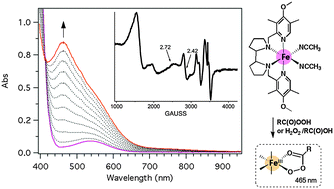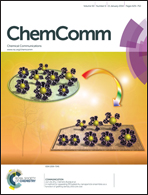H2O2 activation with biomimetic non-haem iron complexes and AcOH: connecting the g = 2.7 EPR signal with a visible chromophore†
Abstract
Mechanistic studies of H2O2 activation by complexes related to [(BPMEN)FeII(CH3CN)2]2+ with electron-rich pyridines revealed that a new intermediate formed in the presence of acetic acid with a 465 nm visible band can be associated with an unusual g = 2.7 EPR signal. We postulate that this chromophore is an acylperoxoiron(III) intermediate.

- This article is part of the themed collection: Biological oxidation reactions: mechanisms and design of new catalysts

 Please wait while we load your content...
Please wait while we load your content...